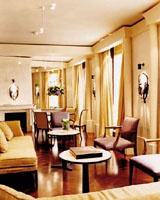 Jasper James
Ten years in the making, the Park Hyatt Paris-Vendôme has finally opened its doors—reviving the cult of the classic hotel. Its style and attitude, however, are anything but business as usual
Jasper James
Ten years in the making, the Park Hyatt Paris-Vendôme has finally opened its doors—reviving the cult of the classic hotel. Its style and attitude, however, are anything but business as usual
For three years, an American company searched Paris for the optimal hotel site. Five more years would pass before construction could proceed. Developers would have to contend with miles of red tape: city ordinances, building permits, legal haggling, and intervention from countless preservation groups. Finally, the Park Hyatt Paris-Vendôme opened its doors—the most eagerly anticipated debut in the French capital since the George V's in 1928.
Although it is a self-described "palace hotel" (in the rarefied company of Paris's Meurice, Ritz, Bristol, Crillon, Plaza Athénée, and George V), the Paris-Vendôme is more boutique than palais. Instead of stuffy white-gloved doormen, guests are greeted by a downright friendly staff (including a female door attendant) dressed in stylish black uniforms. Each day brings design pilgrims, location scouts, and shoppers loaded down with Faubourg St.-Honoré bags, looking to refuel. Every aspect of a guest's stay is orchestrated, from the customized bath products to the curated soundtracks to room safes big enough for laptops.
"Our vision was a palace that was very different from the others," explains Ed Tuttle, an American interior architect who heads his own firm in Paris and is best known for designing exotic resorts—Amanjena in Morocco, Amanpuri in Thailand. For his first European city hotel Tuttle employed the same clean, simple lines and Asian aesthetic that are his trademark: "We wanted to create a hotel with a low-key attitude, good bathrooms with powerful showers, and twenty-first-century comfort and technology."
The location was prime. "It would have cost half the price to build this hotel from scratch," interior architect Ed Tuttle admits. But the Park Hyatt group realized that the cluster of Haussmann-era town houses off the fashionable Rue de la Paix, within shouting distance of the Place Vendôme, would make an impressive hotel. However, the interiors were so labyrinthine that guests would be begging for a map. To fuse the five buildings into a coherent whole, architects had to slice off one of the limestone façades and realign it (a tenth of a millimeter at a time, with computer-controlled hydraulic pumps), level the floors, and pray everything didn't collapse in the process. "This project was like a sick patient who was rushed to the E.R. again and again to be revived," says Michel Jauslin, the hotel's general manager.
The look is streamlined. Froufrou window treatments, Aubusson tapestries, and gilt consoles were discarded. "The idea was to make a very French statement, sensual without being too elaborate or ornate," Tuttle says. "We wanted stripped-down classicism, strong and timeless." The public rooms—in a palette of neutral colors, incorporating limestone and mahogany—unfold like an art gallery, with guests as patrons. Paris-based art dealer Darthea Speyer spent four years assembling a global collection of museum-worthy canvases, including paintings by Americans Sideo Fromboluti and Ed Paschke, Parisian Christiane Durand, and Indian artist Viswanadhan. Bronze sculptures and light fixtures by Roseline Granet are also on display throughout the hotel. Up in the guest rooms, hotel haute couture pervades: furniture is handmade, duvets are silken, golden Roman window shades rustle like party dresses.
The new taste of Paris. Since the September opening, fashionable Parisians have been flocking to the Paris-Vendôme's restaurants and bar. During the day, shoppers lunch at the lobby restaurant, Le Salon Verrière. Its walls are covered with shimmering mauve-colored silk; in the middle of the room, huge twin planters hold hundreds of orchids. In the evening, the champagne bar (serving a dozen varieties by the glass) draws an international crowd, as well as local hipsters in Prada and jeans. The Park—the first open-kitchen restaurant in the city—is a gleaming white space with a serene rotunda in the center. Chef Christophe David, formerly of Taillevent, serves refined but unfussy dishes made with seasonal ingredients. "I buy from eighty different suppliers," he says. "I have a honey man, a mustard man, a potato man, a butter man—everything is the best." The management put the same care into selecting the staff, avoiding employees who had worked at hotels before. "They may not have the experience of the other palaces yet," says Jauslin, "but they have none of the arrogance either. The staff is what gives the Paris-Vendôme its soul."